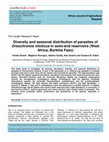Papers by Yamba Judith Sinare
European Scientific Journal, ESJ, Jan 30, 2023
579 familles (Bothriocephallidae, Lytocestidae et Proteocephalidae) ont été récotés. Les espèces ... more 579 familles (Bothriocephallidae, Lytocestidae et Proteocephalidae) ont été récotés. Les espèces rencontrées étaient Tetracampos ciliotheca, Lytocestoides sp, monobothrioides connintoning, Protéocephalus membranacei, Proteocephalus sp1 et Proteocephalus sp2. La famille des Bothriocephalidae était la plus dominante. T. ciliotheca était le cestode qui dominait en nombre et en prévalence dans les périodes étudiées. Plus de la moitié des poissons examinés étaient infectés par T. ciliotheca. C'est un parasite très répandu et connu chez les poissons du genre Clarias.

We investigated parasitic copepods from fishes in Burkina Faso in order to evaluate new trend in ... more We investigated parasitic copepods from fishes in Burkina Faso in order to evaluate new trend in the geographical distribution of fish parasites. From all the parasites that were present in the fishes we investigated, we have found three species groups of copepods, each belonging to a distinct genus: Dysphorus torquatus, Lernaeogiraffa heterotidicola, parasites of Heterotis niloticus (Osteoglossidae) and Lamproglena monodi, parasite of Oreochromis niloticus (Cichlidae). Although most of the copepods appear to be tolerated by their hosts, these species pose a threat to fish farms. Their location preference on the gill arch bone and gill filaments causes these parasites to be of great interest with regard to mechanical damage and the negative physiological consequences they inflict. It is arguable that the parasite copepods collected and studied are potential pathogens as shown by their high intensity of development and their large size.

European Scientific Journal ESJ, 2020
The Trematodes of the genus Mesocoelium parasites of Anurans from Mogtedo, Zam, and Zorgho, in th... more The Trematodes of the genus Mesocoelium parasites of Anurans from Mogtedo, Zam, and Zorgho, in the area of Ganzourgou in Burkina Faso have been investigated between August, 2018 and January 2019. A total of 233 Anurans belonging to 5 families, 5 genera, and 9 species were examined. The species of Anurans examined were: Hoplobatrachus occipitalis, Amnirana galamensis, Ptychadena bibroni, Ptychadena pumilio, Sclerophrys pentoni, Sclerophrys maculata, Sclerophrys regularis, Sclerophrys xeros, and Xenopus fischbergi. The Anurans were collected by hand using the Visual Acoustic Encounter Survey (VAES) method. Amphibians were euthanized and dissected to examine the digestive tract and their appendices for Trematodes of the genus Mesocoelium. A total of 9 species of the genus Mesocoelium were recovered, with an overall prevalence of 11.16%. The Trematodes that have been recovered were: Mesocoelium monas, Mesocoelium brieni, Mesocoelium sociale, Mesocoelium microon, Mesocoelium incognitum, Mesocoelium danforthi, Mesocoelium americanum, Mesocoelium monody, and Mesocoelium megaloon. The means intensity of infestation was generally low except for Mesocoelium incognitum (100.5 parasites / infested host). That infestation was influenced by the selectivity of the host by the Trematodes. It appears that in the 9 species of Anurans examined, only 3 species were infested by parasitic Trematodes (Hoplobatrachus occipitalis, Sclerophrys maculata and Sclerophrys regularis). The preferred organ of the genus Mesocoelium infestations in the host was the small intestine. Histopathologic studies in infested organs will be carried out to show the impacts of the Trematodes of the genus Mesocoelium in their hosts.

Occurrence ofTetracampos ciliotheca(Cestoda: Bothriocephalidea) in the gall bladder ofClarias anguillarisin Burkina Faso
African Journal of Aquatic Science, 2015
The presence of the bothriocephalidean cestode Tetracampos ciliotheca Wedl, 1861 is reported from... more The presence of the bothriocephalidean cestode Tetracampos ciliotheca Wedl, 1861 is reported from the gall bladders of the catfish Clarias anguillaris from Loumbila and Ziga reservoirs, Burkina Faso, in 2010–2011. Of the 159 specimens examined, 47 were infected. Mean intensity of infection was 4.3 parasites per infected host, the maximum was 22 tapeworms in the gall bladder and the mean abundance was 1.3 parasites. There was no significant difference between males and females or between the two localities. There was a positive relationship between fish size and the number of parasites in the gall bladder. This study provides further evidence of the presence of T. ciliotheca in the gall bladder, in which most tapeworms found were localised. Tapeworms were also found in the stomach and intestine, with prevalences of 1% and 16%, and mean infection intensities of 1 and 5.3, respectively.
Bats were sampled in five localities in Burkina Faso using mist nets from August to November 2018... more Bats were sampled in five localities in Burkina Faso using mist nets from August to November 2018. This study was carried out by carrying out captures and handling in order to know the species present, their number, their sex, their reproductive status, and their age group. In total, 341 bats of eight species were captured representing 15.68% of bats species known to occur in Burkina Faso. Mauritian Tomb Bat, Taphozous mauritianus E. Geoffroy St.-Hilaire, 1818 is reported for the first time in Burkina Faso and represented by two individuals raising the total species for the country to 52. Bats species richness and abundance were highest at Bobo Dioulasso. Future large-scale studies in time and space could make it possible to fully appreciate the evolution of bats biodiversity in Burkina Faso, especially in the context of climate change.

International Journal of Biological and Chemical Sciences, 2021
Paracamallanus cyathopharynx, Procamallanus laevichoncus, Rhabdochona congolensis, Contracaecum s... more Paracamallanus cyathopharynx, Procamallanus laevichoncus, Rhabdochona congolensis, Contracaecum sp., Anisakis sp. et une espèce non identifiée. Les nématodes étaient plus nombreux dans le réservoir de Ziga. Cependant, la prévalence des nématodes n’a pas varié dans les deux sites. Les nématodes adultes étaient plus diversifiés dans le tube digestif et les larves étaient fréquentes dans la cavité et dans les tissus des organes. Parmi les espèces de nématodes étudiés, Anisakis sp. a été rencontrée chez les poissons pour la première fois au Burkina Faso. Cette investigation a permis de connaître les espèces de nématodes qu’héberge C. anguillaris au Burkina Faso. Ces espèces n’avaient pas la même distribution chez l’hôte de même que les différents stades. Les adultes étaient rencontrés dans le tube digestif et les larves dans les tissus et les mésentères English title: Nematode distribution pattern in catfish (Clarias anguillaris (Linnaeus, 1758)) in two reservoirs of Burkina Faso (West ...

African Journal of Agricultural Research, 2016
This study aimed to investigate the diversity, abundance, intensity, and seasonal distribution of... more This study aimed to investigate the diversity, abundance, intensity, and seasonal distribution of parasites of Oreochromis niloticus. A total of 254 specimens of O. niloticus was sampled in Loumbila and Ziga reservoirs in both rainy and dry season and examined for parasites. The total prevalence was 55.90% and the highest seasonal prevalence, abundance and intensity were observed during the rainy season. Recorded parasites were the myxozoan Myxobolus tilapiae, the copepode Lamproglena monodi, the monogeneans Cichlidogyrus tilapiae, Cichlidogyrus halli, the digenetic trematode Clinostomum species, the nematode Paracamallanus cyathopharynx, and the acanthocephalan Acanthogyrus tilapiae. The latter species had higher prevalence (45.67%) and high abundance. L. monodi, C. tilapiae, C. halli, and P. cyathopharynx were only observed in Loumbila reservoir. A. tilapiae, Clinostomum spp. and M. tilapiae were found in both reservoirs with a high abundance. In conclusion, it was found out that ...

International Journal of Biological and Chemical Sciences
Paracamallanus cyathopharynx, Procamallanus laevichoncus, Rhabdochona congolensis, Contracaecum s... more Paracamallanus cyathopharynx, Procamallanus laevichoncus, Rhabdochona congolensis, Contracaecum sp., Anisakis sp. et une espèce non identifiée. Les nématodes étaient plus nombreux dans le réservoir de Ziga. Cependant, la prévalence des nématodes n’a pas varié dans les deux sites. Les nématodes adultes étaient plus diversifiés dans le tube digestif et les larves étaient fréquentes dans la cavité et dans les tissus des organes. Parmi les espèces de nématodes étudiés, Anisakis sp. a été rencontrée chez les poissons pour la première fois au Burkina Faso. Cette investigation a permis de connaître les espèces de nématodes qu’héberge C. anguillaris au Burkina Faso. Ces espèces n’avaient pas la même distribution chez l’hôte de même que les différents stades. Les adultes étaient rencontrés dans le tube digestif et les larves dans les tissus et les mésentères English title: Nematode distribution pattern in catfish (Clarias anguillaris (Linnaeus, 1758)) in two reservoirs of Burkina Faso (West ...
Uploads
Papers by Yamba Judith Sinare